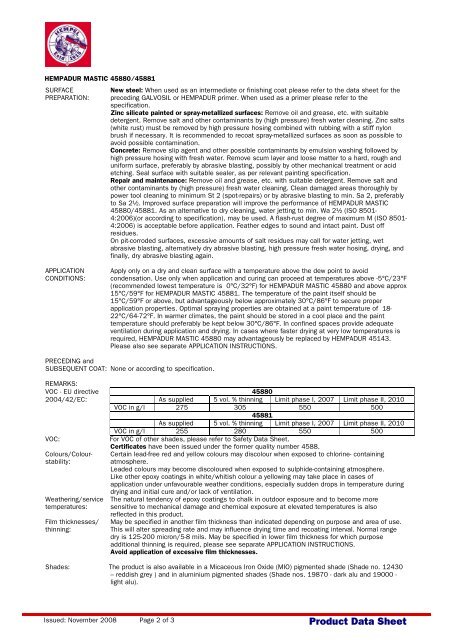English (United Kingdom) - Paul Wurth
English (United Kingdom) - Paul Wurth
English (United Kingdom) - Paul Wurth
- TAGS
- wurth
- www.paulwurth.com
Create successful ePaper yourself
Turn your PDF publications into a flip-book with our unique Google optimized e-Paper software.
HEMPADUR MASTIC 45880/45881<br />
SURFACE New steel: When used as an intermediate or finishing coat please refer to the data sheet for the<br />
PREPARATION: preceding GALVOSIL or HEMPADUR primer. When used as a primer please refer to the<br />
specification.<br />
Zinc silicate painted or spray-metallized surfaces: Remove oil and grease, etc. with suitable<br />
detergent. Remove salt and other contaminants by (high pressure) fresh water cleaning. Zinc salts<br />
(white rust) must be removed by high pressure hosing combined with rubbing with a stiff nylon<br />
brush if necessary. It is recommended to recoat spray-metallized surfaces as soon as possible to<br />
avoid possible contamination.<br />
Concrete: Remove slip agent and other possible contaminants by emulsion washing followed by<br />
high pressure hosing with fresh water. Remove scum layer and loose matter to a hard, rough and<br />
uniform surface, preferably by abrasive blasting, possibly by other mechanical treatment or acid<br />
etching. Seal surface with suitable sealer, as per relevant painting specification.<br />
Repair and maintenance: Remove oil and grease, etc. with suitable detergent. Remove salt and<br />
other contaminants by (high pressure) fresh water cleaning. Clean damaged areas thoroughly by<br />
power tool cleaning to minimum St 2 (spot-repairs) or by abrasive blasting to min. Sa 2, preferably<br />
to Sa 2½. Improved surface preparation will improve the performance of HEMPADUR MASTIC<br />
45880/45881. As an alternative to dry cleaning, water jetting to min. Wa 2½ (ISO 8501-<br />
4:2006)(or according to specification), may be used. A flash-rust degree of maximum M (ISO 8501-<br />
4:2006) is acceptable before application. Feather edges to sound and intact paint. Dust off<br />
residues.<br />
On pit-corroded surfaces, excessive amounts of salt residues may call for water jetting, wet<br />
abrasive blasting, alternatively dry abrasive blasting, high pressure fresh water hosing, drying, and<br />
finally, dry abrasive blasting again.<br />
APPLICATION Apply only on a dry and clean surface with a temperature above the dew point to avoid<br />
CONDITIONS: condensation. Use only when application and curing can proceed at temperatures above -5°C/23°F<br />
(recommended lowest temperature is 0°C/32°F) for HEMPADUR MASTIC 45880 and above approx<br />
15°C/59°F for HEMPADUR MASTIC 45881. The temperature of the paint itself should be<br />
15°C/59°F or above, but advantageously below approximately 30°C/86°F to secure proper<br />
application properties. Optimal spraying properties are obtained at a paint temperature of 18-<br />
22°C/64-72°F. In warmer climates, the paint should be stored in a cool place and the paint<br />
temperature should preferably be kept below 30°C/86°F. In confined spaces provide adequate<br />
ventilation during application and drying. In cases where faster drying at very low temperatures is<br />
required, HEMPADUR MASTIC 45880 may advantageously be replaced by HEMPADUR 45143.<br />
Please also see separate APPLICATION INSTRUCTIONS.<br />
PRECEDING and<br />
SUBSEQUENT COAT: None or according to specification.<br />
REMARKS:<br />
VOC - EU directive 45880<br />
2004/42/EC: As supplied 5 vol. % thinning Limit phase I, 2007 Limit phase II, 2010<br />
VOC in g/l 275 305 550 500<br />
45881<br />
As supplied 5 vol. % thinning Limit phase I, 2007 Limit phase II, 2010<br />
VOC in g/l 255 280 550 500<br />
VOC: For VOC of other shades, please refer to Safety Data Sheet.<br />
Certificates have been issued under the former quality number 4588.<br />
Colours/Colour- Certain lead-free red and yellow colours may discolour when exposed to chlorine- containing<br />
stability: atmosphere.<br />
Leaded colours may become discoloured when exposed to sulphide-containing atmosphere.<br />
Like other epoxy coatings in white/whitish colour a yellowing may take place in cases of<br />
application under unfavourable weather conditions, especially sudden drops in temperature during<br />
drying and initial cure and/or lack of ventilation.<br />
Weathering/service The natural tendency of epoxy coatings to chalk in outdoor exposure and to become more<br />
temperatures: sensitive to mechanical damage and chemical exposure at elevated temperatures is also<br />
reflected in this product.<br />
Film thicknesses/ May be specified in another film thickness than indicated depending on purpose and area of use.<br />
thinning: This will alter spreading rate and may influence drying time and recoating interval. Normal range<br />
dry is 125-200 micron/5-8 mils. May be specified in lower film thickness for which purpose<br />
additional thinning is required, please see separate APPLICATION INSTRUCTIONS.<br />
Avoid application of excessive film thicknesses.<br />
Shades: The product is also available in a Micaceous Iron Oxide (MIO) pigmented shade (Shade no. 12430<br />
– reddish grey ) and in aluminium pigmented shades (Shade nos. 19870 - dark alu and 19000 -<br />
light alu).<br />
Issued: November 2008 Page 2 of 3<br />
Product Data Sheet




